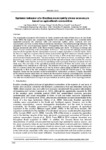Please use this identifier to cite or link to this item:
http://www.alice.cnptia.embrapa.br/alice/handle/doc/1027001| Title: | Systemic behavior of a Brazilian municipality whose economy is based on agricultural commodities. |
| Authors: | BULLER, L. S.  ORTEGA, E.   ZANETTI, M. R.   BERGIER, I.   |
| Affiliation: | LUZ SELENE BULLER, UNICAMP; ENRIQUE ORTEGA, UNICAMP; MARILIA RIBEIRO ZANETTI, UNICAMP; IVAN BERGIER TAVARES DE LIMA, CPAP. |
| Date Issued: | 2015 |
| Citation: | In: BIENNIAL INTERNATIONAL WORKSHOP ADVANCES IN ENERGY STUDIES, 9., 2015, Stockholm. Energy and urban systems. [Graz]: Verlag der Technischen Universität Graz, 2015. |
| Pages: | p. 142-149. |
| Description: | The municipality evaluated is São Gabriel do Oeste, located in the state of Mato Grosso do Sul, Brazil. In the 1960's the region was occupied by migrants from southern Brazil who have converted native vegetation (savanna) into extensive cattle and monocrops (coffee, cotton, soybeans and corn, successively), and more recently intensive swine was introduced. The following emergy indicators were calculated for the current municipal situation: Renewability (%R): 8%; Emergy yield ratio (EYR): 14; Emergy investment ratio (EIR): 0.08; Environmental loading ratio (ELR): 11; Emergy exchange ratio (EER): 13 and Transformity of the commodities: 8x105seJ.J-1. The very low %R and high environmental pressure (ELR) signalize that the municipality's economy is highly dependent on external inputs. Above all, there is a high loss of system internal stocks (soil) and the high EYR obtained is directly related to this predatory land use. The emergy value of the soil loss is 83% of the total emergy, which is an environmental imbalanced situation. The main land use in São Gabriel do Oeste, accounting for 39% of the territory, is extensive cattle farming that demands few agricultural inputs, what explains the very low EIR. The EER shows that the rural area is subsidizing urban economies that import products from the study area. The real value of the agricultural products should be 13 times the market value of such commodities to be considered as a fair trade. The inclusion of soil loss as a negative externality shows that (in economic terms) the amount of soil lost by erosion and leaching (4,149x106 emUSD.year-1) corresponds to 46% of the total production monetary value (9,018x106 emUSD.year-1). The emergy diagnosis shows that the business model established for commodities producers is highly dependent on the external market, which does not remunerate the imported resources accordingly to its real value. To settle this situation, a dialogue between farmers, consumers and authorities should be established. The latter two should involve not only local representatives as well as players of the importing countries. |
| Thesagro: | Agricultura Desenvolvimento econômico |
| NAL Thesaurus: | Agricultural products Economic development |
| Keywords: | Commodities Farmland São Gabriel do Oeste |
| Notes: | BIWAES 2015. |
| Type of Material: | Artigo em anais e proceedings |
| Access: | openAccess |
| Appears in Collections: | Artigo em anais de congresso (CPAP)  |
Files in This Item:
| File | Description | Size | Format | |
|---|---|---|---|---|
| PDFIvan.pdf | 40.72 MB | Adobe PDF |  View/Open |









